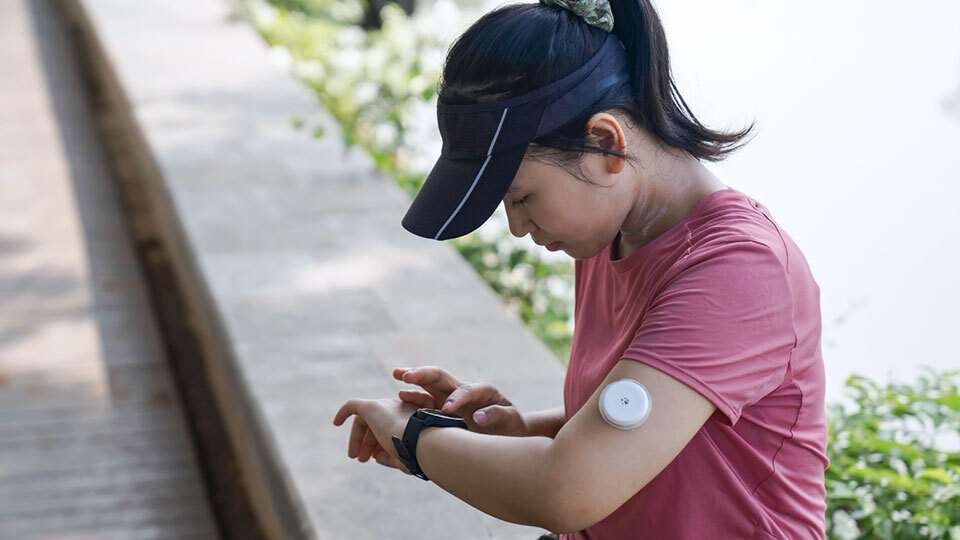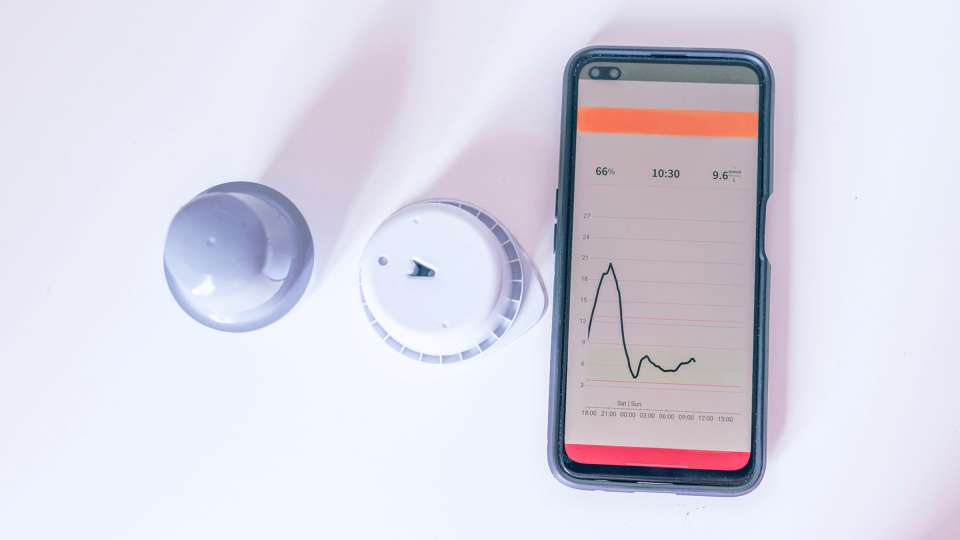
Sleep, heart rate, mood, nutrition, periods: Nowadays, you can easily track almost every aspect of your health. The newest trend? Tracking your blood sugar — even when you don’t have diabetes.
Continuous glucose monitors are wearable devices that read your blood sugar level every few minutes. For people with diabetes, the monitors can notify them about episodes of hyper- and hypoglycemia — aka dangerously high or low blood sugar — and help them manage their condition along with their doctor’s help.
But now that the U.S. Food and Drug Administration has recently made some monitors available over the counter, some people without diabetes are wearing the monitors, as well. They claim that doing so helps prevent blood sugar spikes and allows them to better understand how different foods affect their health.
But are these claims true? Should you wear a continuous glucose monitor even if you don’t have diabetes?
What is your blood glucose?
Your body uses glucose from food as energy. It is absorbed from your intestines into your blood, which transports it to your cells.
The level of glucose in your blood is called your blood glucose or blood sugar. When your blood glucose rises, your body releases insulin, which causes the sugar to move out of the blood and into your cells, bringing your blood sugar down.
People with type 1 diabetes are unable to make insulin. In people with type 2 diabetes, insulin is present but is unable to bring blood sugar down to normal in a timely manner on its own.
In people without diabetes, your blood sugar levels should be between 70 to 160 mg/dL during the day.
How does a continuous glucose monitor work?
Continuous glucose monitors measure the glucose circulating in the fluid between the cells in your body, not specifically in your blood, but the amounts are nearly the same in each location.
A sensor in the monitor takes the measurements and sends data to a receiver, usually an app on a smartphone. The monitor will alert someone if their blood sugar reading is too high or low.
The over-the-counter monitors are made up of a small filament with a sensor and adhesive patch. They can be installed by the user via a small needle; other types are installed by a doctor just under the skin on someone’s arm.
Who should use a continuous glucose monitor?
The monitors are recommended for all patients with type I diabetes and all patients with type II diabetes who are on insulin, says Dr. Lorena Alarcon-Casas Wright, an endocrinologist, specialist in treating diabetes and the clinic director of the LatinX Diabetes Clinic at the UW Diabetes Institute at South Lake Union. Insurance typically covers the cost of the monitors for these patients, though not always for those with type II diabetes who aren’t taking insulin.
She also believes the monitors can be helpful for people who are at risk for diabetes or who have diabetes but are not taking insulin. This could include people with pre-diabetes or with another medical condition, such as polycystic ovary syndrome aka PCOS, that puts someone more at risk for developing diabetes.
“Where I see CGMs being very useful is when someone can learn about what kinds of foods affect their blood sugar the most, which can help them modify their diet,” she explains. “Or they can see that when they go for a walk, their blood sugar goes down, so they see the benefit of exercise.”
Should you use a continuous glucose monitor to prevent blood sugar spikes?
Blood sugar typically rises after a meal; this is normal and just means your body is processing the food you just fed it.
A true blood sugar spike, aka hyperglycemia, is a dramatic and often rapid increase in blood sugar levels. People with diabetes experience blood sugar spikes sometimes, and if not treated, those spikes can be very dangerous.
If you don’t have diabetes and aren’t at risk for it, you shouldn’t experience dramatic blood sugar spikes. And as long as you’re eating a balanced diet, you shouldn’t experience higher-than-normal blood sugar increases after you eat.
Occasionally, a large quantity of sugary food may make someone’s blood sugar increase more than normal post-feast, but this isn’t a problem as long as it’s not the way you eat regularly.
Since people without diabetes don’t need to worry about hyperglycemia, they don't need to wear continuous glucose monitors; doing so is a personal choice if they want more information about their blood sugar. Wright doesn’t discourage people from wearing a monitor if they really want to. However, she does caution people not to take a single blood sugar reading too seriously.
“CGMs are not 100% accurate; we don’t use them to make a diagnosis of diabetes or hypoglycemia,” she says. “If someone without diabetes is using a CGM, they might get very concerned if their blood sugar goes up or down, but the CGM is just a guide. It tells you about patterns; it is not a diagnostic tool.”
So if you’re wearing a monitor and you eat a cookie and your blood sugar increases a little extra, don’t panic. Instead, see what happens the next time you eat the same thing, and the next. You can learn which foods are more likely to make your blood sugar increase or decrease and use that information to adjust what you eat, if you wish to.
In general, sugary and ultra-processed foods are much more likely to make blood sugar increase more; fruits and vegetables and other whole foods with fiber and protein typically won’t.
Over time, however, repeated blood sugar spikes might put someone at risk for insulin resistance, prediabetes, heart problems or even type 2 diabetes.
Should you use a continuous glucose monitor to try nutrient sequencing?
It’s become trendy among some influencers to use a glucose monitor to note how different foods affect their blood sugar, then practice nutrient sequencing to try to avoid blood sugar spikes. Nutrient sequencing means eating foods in a specific order, typically fats, then proteins, then carbs.
The idea is that the fats and proteins, which take longer to be absorbed by the body, will sit in the stomach longer. If carbs are eaten after, they will get delayed in the stomach backlog, too, rather than rushing through and being absorbed quickly.
While it’s true that nutrient sequencing can help prevent blood sugar spikes, Wright only recommends it to patients who have diabetes.
“If someone doesn’t have diabetes and eats healthy, I don’t think they have to worry about the sequence of how they eat their meals,” she says.
What are the best ways to prevent type 2 diabetes?
While a glucose monitor might help you learn helpful information about your blood sugar, it alone won’t help you prevent diabetes. But there are some lifestyle changes you can make that will help keep you healthy:
- Eat a balanced diet with a mixture of fats, proteins and carbs.
- Limit ultra-processed foods as much as possible.
- Stay active; even moving a little each day is helpful.
- Maintain a healthy weight.
- Take steps to reduce the amount of stress in your life.
- Prioritize getting enough sleep each night.
“Try to be mindful of health without being anxious about it,” Wright says.

 Healthy ideas for your inbox
Healthy ideas for your inbox






